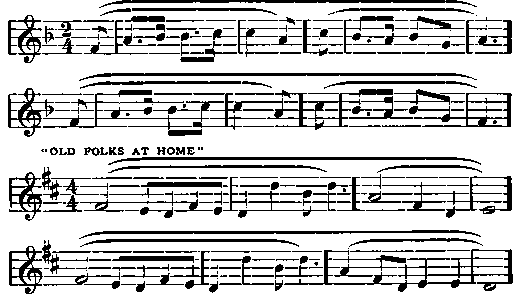Harmony Book For Beginners - online book
Scales, Intervals, Common Chords, Dominant Seventh Chord and Melody Making.
| Share page | Visit Us On FB |
|
140 |
OREM'S HARMONY BOOK |
||
|
CHAPTER XXX |
|||
|
|
|||
|
ON MELODY MAKING
The Elements of Music are Melody, Rhythm and Harmony.
Melody is a succession of musical sounds, arranged according to a certain order or design.
Rhythm is movement in musical time.
The student who has mastered the contents of this book up to this point knows very well what Harmony is.
Musical Composition is the art of building up musical ideas into larger and continuous forms.
In the Art of Music, as in all the Fine Arts, creative work is governed by certain Principles: the Principles of Unity, Variety and Proportion. These Principles apply just as much in the making of the simplest Melody as they do in the largest musical effort.
By Unity we mean oneness, individuality.
By Variety we mean diversity, state of difference.
By Proportion we mean the symmetrical relation of one part to another.
We must not observe any one of these Principles to the exclusion of the others, but we must follow each in equal measure.
The ambitious student who has reached this point should feel inspired to original creative effort. Hence, the foregoing definitions and remarks.
By the practice of Melody Making the student will acquire the ability to put his own tone thoughts into definite form and to improve his understanding of all that he may hear.
Referring to the Principles of Unity, Variety and Proportion one may find illustrations in many familiar objects. Take a piece of wall paper, for instance. There is always a Principal Unit which pervades the entire design. That is Unity. There are Lesser Units which serve to vary or to afford contrast to the Principal Unit. That is Variety. The Principal Unit and the Lesser Units are repeated over and over again in a symmetrical design. That is Proportion. Read a verse of poetry and seek similar illustrations in it. Look at a perfect piece of Architecture and find still greater illustrations. Let the student work out other illustrations.
Now for some Musical applications of our Principles. An examination of familiar melodies discloses the fact that, with but few exceptions, all seem to proceed by rhythmic groups of two or four measures, and multiples of the same.
Here are some examples: |
|||
|
|
|||
|
"HOME, SWEET HOME |
|||
|
|
|||
 |
|||